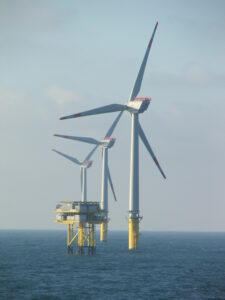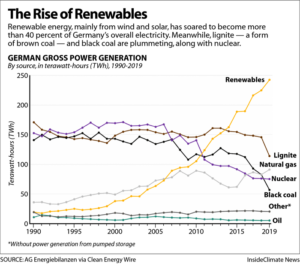
Popularly known as the “Energiewende” in Germany, is the energy transition from the concentrated use of fossil fuels to a shift of renewable energy. This coined termed is based on the context of lowering the worlds greenhouse gas emissions in hopes to not exceed the 1.5-degree goal. Within the top 90 oil and gas firms, 63% of the global carbon and methane emissions are sourced within them (Ekwurzel, 2017). As a result, Germany is trying to diversify its energy sources in hopes to produce less greenhouse gas emissions by investing more funds into renewable energy. Wind energy is a key component of Germany’s renewable energy mix.
As of early 2023, Germany’s share of renewable energy throughout all the energy sources is 44.2% (Wehrmann, 2023). Of the renewable energy sector, nearly half of the renewable energy is sourced from wind power at 21.6% (Wehrmann, 2023). By increasing levels of renewable energy, they are trying to shift away from fossil fuel. While in the United States, they are still very far behind in their energy transition and only have about 17.5% of their energy sourced from renewable energy (Gearino, 2020).

One way Germany has really set the precedents is their offshore windfarm projects. They realized that they were running out of land space to put their windfarms and in order to reach their renewable energy goals their best option would be to increase off-shore wind farms. Because of Germany’s shoreline to the Baltic and North Sea, they were able to install 29 operating offshore wind farms and 1 is in construction out of 188 offshore wind projects that have been approved (Offshore Wind farms in Germany, 2023). It has also been a great way to boost the economy as it has around 21,400 people working in the industry and has generated an annual turnover of 7.4 billion euros in the industry (Wehrmann, 2023). It has also brought numerous investors into the renewable energy industry markets.
Moreover, the United States currently has only 2 offshore windfarms (Offshore Wind Energy, n.d.). The United States has 8 times more coastline than Germany giving them ample opportunity to invest more into their offshore windfarms (Geography Stats: compare key data on Germany & United States, n.d.). Increasing offshore wind capacity is a viable option for the United States however, there has been a lot of pushbacks from communities as it may not be aesthetically appealing. In addition, U.S. policies are delaying the development of offshore wind farms by enforcing the Jones Act of 1920 permits all parts of a windmill to be constructed, registered, and managed by crews within the United States (Marshall, 2023). It is predicted that by 2050 there could be windfarms in every coastal region within the United States (Offshore Wind Energy, n.d.).
Germany started their first windfarm in 2014 and has since expanded their operation to help combat climate change and increase their economy. The United States is capable of creating more windfarms, but they lack the large political backing for environmental issues that Germany has.
References:
Ekwurzel, B. e. (2017). The rise in global atmospheric CO2, surface temperature, and sea level from emissions traced to major carbon producers. Climatic Change, 579–590.
Gearino, D. (2020, April 30). How Dying Forests and a Swedish Teenager Helped Revive Germany’s Clean Energy Revolution. Retrieved from Inside Climate News: https://insideclimatenews.org/news/30042020/germany-energy-renewables-solar-wind-climate-change-warming/
Geography Stats: compare key data on Germany & United States. (n.d.). Retrieved from Nation Master: https://www.nationmaster.com/country-info/compare/Germany/United-States/Geography
Marshall, M. (2023, February 14). What’s holding the United States back from being a global leader in offshore wind? Retrieved from Yale Environment Review: https://environment-review.yale.edu/whats-holding-united-states-back-being-global-leader-offshore-wind
Offshore Wind Energy. (n.d.). Retrieved from WIND Exchange : https://windexchange.energy.gov/markets/offshore
Offshore Wind farms in Germany. (2023, April 30). Retrieved from 4 C Offshore: https://www.4coffshore.com/windfarms/germany/#:~:text=Germany%20has%20188%20offshore%20wind,or%20have%20applied%20for%20consent.
Wehrmann, B. (2023, February 13). German onshore wind power – output, business and perspectives. Retrieved from Journalism for the energy transition : https://www.cleanenergywire.org/factsheets/german-onshore-wind-power-output-business-and-perspectives

